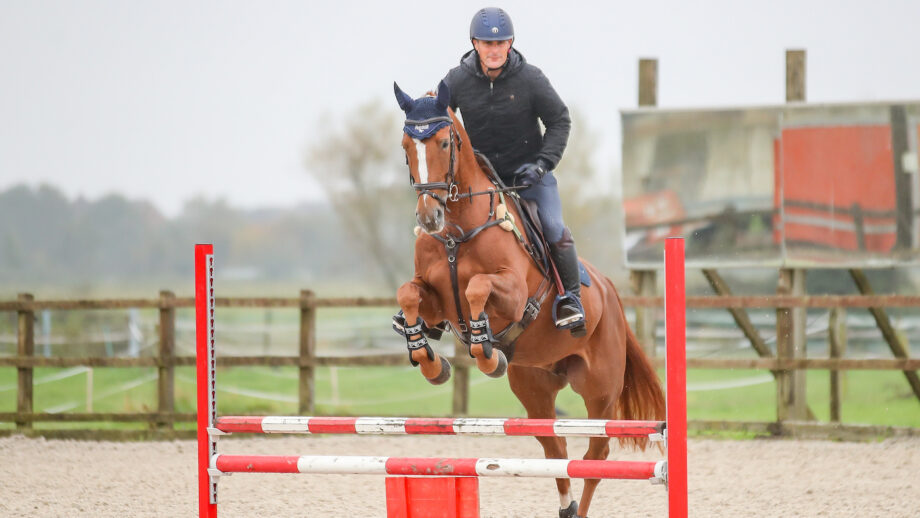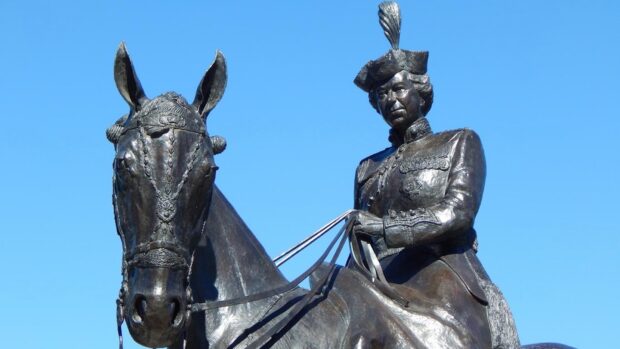Staying soft yet secure over fences is something we often attribute to the rider, but what does the same phrase mean for a horse? Alex Bragg offers this training exercise on a fan to encourage engagement and softness on a curve.
“A horse can’t engage the hindleg and deliver a powerful jump if he’s tense or crooked,” says the five-star event rider. “We look for softness in flatwork, and in dressage training you’ll often want that ‘spiralling out’ feeling where the horse yields to the inside aids and seeks the outside rein, stepping under and through with the inside hind. If we apply that same feeling over fences, we keep the engagement of that hindleg for better balance, softness and power.”
Cultivating that softness takes conditioning: “You imagine the core strength a horse needs to lift his whole body – bearing in mind he is around 600kg – and keep it all carried. They need to be strong.”
To achieve this as well as banish tension, the muscles need to be strong in all directions.
“You want to stretch and flex the muscles,” explains Alex. “The further you can stretch and flex, the more range you’ll have and the more athletic your horse can be.
“The young horse I am riding to demonstrate this training exercise has a short neck,” Alex Bragg continues. “I want him to develop self-carriage, but first, he needs to use what neck he does have to the maximum.
“It’s important I get his topline as long as possible before I start to collect him, or that’s when you’ll develop tension and blocking at the base of the neck, which will hinder his back end.”
Alex Bragg training exercise: keep the curve
Working on: the horse’s softness, strength and balance, keeping him true to the path through the fanned fences
{"content":"PHA+WW914oCZbGwgbmVlZCB0aHJlZSB1cHJpZ2h0IGZlbmNlcyBzZXQgb3V0IG9uIGEgY3VydmluZyBsaW5lLCB3aXRoIGFib3V0IHNldmVuIGh1bWFuIHBhY2VzIGJldHdlZW4gZWFjaCBhdCB0aGUgbWlkZGxlLiBBbGV4IHVzZXMgYSBzb2xpZCBncm91bmRsaW5lIGZvciBlYWNoIGZlbmNlIGFuZCBsZWF2ZXMgcG9sZXMgb24gdGhlIGZsb29yIGF0IHRoZSBpbnNpZGUgZWRnZSBvZiB0aGUgY3VydmUgaW4gY2FzZSB0aGV54oCZcmUgbmVlZGVkLjwvcD4KPHA+PGRpdiBpZD0iYXR0YWNobWVudF84ODQ4NjEiIHN0eWxlPSJ3aWR0aDogMTQxMHB4IiBjbGFzcz0id3AtY2FwdGlvbiBhbGlnbm5vbmUiPjxpbWcgZmV0Y2hwcmlvcml0eT0iaGlnaCIgZGVjb2Rpbmc9ImFzeW5jIiBhcmlhLWRlc2NyaWJlZGJ5PSJjYXB0aW9uLWF0dGFjaG1lbnQtODg0ODYxIiBjbGFzcz0ibGF6eWxvYWQgYmx1ci11cCBzaXplLWZ1bGwgd3AtaW1hZ2UtODg0ODYxIiBkYXRhLXByb2Nlc3NlZCBzcmM9Imh0dHBzOi8va2V5YXNzZXRzLnRpbWVpbmN1ay5uZXQvaW5zcGlyZXdwL2xpdmUvd3AtY29udGVudC91cGxvYWRzL3NpdGVzLzE0LzIwMTcvMDMvbmV3LWhoLXBsYWNlaG9sZGVyLTIwMHgyMDAucG5nIiBkYXRhLXNyYz0iaHR0cHM6Ly9rZXlhc3NldHMudGltZWluY3VrLm5ldC9pbnNwaXJld3AvbGl2ZS93cC1jb250ZW50L3VwbG9hZHMvc2l0ZXMvMTQvMjAyNS8wMi9CdWlsZC1pdC1CSF9BTEVYX0JSQUdHXzIwMjQxMDE0LTIxMC5qcGciIGFsdD0iQWxleCBCcmFnZyBzZXR0aW5nIHVwIGEgdHJhaW5pbmcgZXhlcmNpc2UiIHdpZHRoPSIxNDAwIiBoZWlnaHQ9Ijc4OCIgZGF0YS1zaXplcz0iYXV0byIgZGF0YS1zcmNzZXQ9Imh0dHBzOi8va2V5YXNzZXRzLnRpbWVpbmN1ay5uZXQvaW5zcGlyZXdwL2xpdmUvd3AtY29udGVudC91cGxvYWRzL3NpdGVzLzE0LzIwMjUvMDIvQnVpbGQtaXQtQkhfQUxFWF9CUkFHR18yMDI0MTAxNC0yMTAuanBnIDE0MDB3LCBodHRwczovL2tleWFzc2V0cy50aW1laW5jdWsubmV0L2luc3BpcmV3cC9saXZlL3dwLWNvbnRlbnQvdXBsb2Fkcy9zaXRlcy8xNC8yMDI1LzAyL0J1aWxkLWl0LUJIX0FMRVhfQlJBR0dfMjAyNDEwMTQtMjEwLTMwMHgxNjkuanBnIDMwMHcsIGh0dHBzOi8va2V5YXNzZXRzLnRpbWVpbmN1ay5uZXQvaW5zcGlyZXdwL2xpdmUvd3AtY29udGVudC91cGxvYWRzL3NpdGVzLzE0LzIwMjUvMDIvQnVpbGQtaXQtQkhfQUxFWF9CUkFHR18yMDI0MTAxNC0yMTAtNjMweDM1NS5qcGcgNjMwdywgaHR0cHM6Ly9rZXlhc3NldHMudGltZWluY3VrLm5ldC9pbnNwaXJld3AvbGl2ZS93cC1jb250ZW50L3VwbG9hZHMvc2l0ZXMvMTQvMjAyNS8wMi9CdWlsZC1pdC1CSF9BTEVYX0JSQUdHXzIwMjQxMDE0LTIxMC0xMzV4NzYuanBnIDEzNXcsIGh0dHBzOi8va2V5YXNzZXRzLnRpbWVpbmN1ay5uZXQvaW5zcGlyZXdwL2xpdmUvd3AtY29udGVudC91cGxvYWRzL3NpdGVzLzE0LzIwMjUvMDIvQnVpbGQtaXQtQkhfQUxFWF9CUkFHR18yMDI0MTAxNC0yMTAtMzIweDE4MC5qcGcgMzIwdywgaHR0cHM6Ly9rZXlhc3NldHMudGltZWluY3VrLm5ldC9pbnNwaXJld3AvbGl2ZS93cC1jb250ZW50L3VwbG9hZHMvc2l0ZXMvMTQvMjAyNS8wMi9CdWlsZC1pdC1CSF9BTEVYX0JSQUdHXzIwMjQxMDE0LTIxMC02MjB4MzQ5LmpwZyA2MjB3LCBodHRwczovL2tleWFzc2V0cy50aW1laW5jdWsubmV0L2luc3BpcmV3cC9saXZlL3dwLWNvbnRlbnQvdXBsb2Fkcy9zaXRlcy8xNC8yMDI1LzAyL0J1aWxkLWl0LUJIX0FMRVhfQlJBR0dfMjAyNDEwMTQtMjEwLTkyMHg1MTguanBnIDkyMHcsIGh0dHBzOi8va2V5YXNzZXRzLnRpbWVpbmN1ay5uZXQvaW5zcGlyZXdwL2xpdmUvd3AtY29udGVudC91cGxvYWRzL3NpdGVzLzE0LzIwMjUvMDIvQnVpbGQtaXQtQkhfQUxFWF9CUkFHR18yMDI0MTAxNC0yMTAtMTIyMHg2ODcuanBnIDEyMjB3IiBzaXplcz0iKG1heC13aWR0aDogMTQwMHB4KSAxMDB2dywgMTQwMHB4IiAvPjxwIGlkPSJjYXB0aW9uLWF0dGFjaG1lbnQtODg0ODYxIiBjbGFzcz0id3AtY2FwdGlvbi10ZXh0Ij5UaGUgZmFuIGNvbnNpc3RzIG9mIHRocmVlIGZlbmNlcyB3aXRoIG9uZSBob3JzZeKAmXMgc3RyaWRlIGJldHdlZW4gZWFjaCwgb24gYSBjdXJ2ZS4gQ3JlZGl0OiBFbGxpIEJpcmNoL0Jvb3RzYW5kaG9vdmVzPC9wPjwvZGl2PjxiciAvPgo8L3A+CjxoMz5BaW1zPC9oMz4KPHA+4oCcV2XigJlyZSB0cnlpbmcgdG8gZ2V0IHRoZSBob3JzZSB0byBqdW1wLCBidXQgc3RheSBlbmdhZ2VkIHdpdGggdGhlIGhpbmRsZWcs4oCdIHNheXMgQWxleC4g4oCcV2XigJlyZSB0dXJuaW5nIHNsaWdodGx5LCBzbyB3ZSBuZWVkIHRvIG1ha2Ugc3VyZSB0aGUgaG9yc2UgZG9lc27igJl0IGZhbGwgb3V0IG9yIGtuaWZlIGluLiBXZSBhbG1vc3Qgd2FudCBpdCB0byBmZWVsIGFzIGlmIHRoZXkgYXJlIGNhbnRlcmluZyBvbiB0aGUgbGluZSBhbmQgdGhlIGp1bXBzIGFyZSBqdXN0IGluIHRoZSB3YXkuPC9wPgo8cD7igJxNeSBmb2N1cyBpcyBtYWludGFpbmluZyBiYWxhbmNlIG9uIHRoZSBsaW5lLCBhbmQgdGhlIGhvcnNlIGp1c3QgaGFzIHRvIHNvZnRlbi7igJ08L3A+Cgo8aDM+V2FybS11cDwvaDM+CjxwPkFmdGVyIGxvb3NlbmluZyB1cCBpbiBhbGwgdGhyZWUgZ2FpdHMsIEFsZXggY29tZXMgb250byBhIGNpcmNsZSBpbiBjYW50ZXIuPC9wPgo8cD7igJxIZXJlLCBJ4oCZbSBwdXNoaW5nIHdpdGggbXkgaW5zaWRlIGxlZyBhbmQgdXNpbmcgbW9yZSBhbmdsZSDigJMgbGlrZSBhIHNob3VsZGVyLWZvcmUgcG9zaXRpb24s4oCdIGhlIHNheXMuIOKAnFRoaXMgaXMgYXNraW5nIGhpbSB0byBlbmdhZ2UgdGhlIGluc2lkZSBoaW5kIGZvciBiZXR0ZXIgYmFsYW5jZS7igJ08L3A+CjxwPkFsZXggaGFzIGEgdGVsbC10YWxlIHNpZ24gdG8gZGV0ZWN0IHNlbGYtY2FycmlhZ2U6IOKAnFdoZW4gaGXigJlzIGNhcnJ5aW5nIGhpbXNlbGYsIGhlIGRvZXNu4oCZdCBsZWFuIHRvIHRoZSBvdXRzaWRlIGFuZCBJIGRvbuKAmXQgaGF2ZSB0byBrZWVwIHRyeWluZyB0byBndWlkZSBoaXMgc2hvdWxkZXJzIHdpdGggdGhlIGluc2lkZSByZWluLiBJIGNhbiBhY3R1YWxseSBzb2Z0ZW4gdGhlIGluc2lkZSByZWluLCB3aGljaCBhbGxvd3MgaGltIHRvIHNlZWsgdGhlIG91dHNpZGUgcmVpbi7igJ08L3A+CjxwPlRoZSBhbmdsZSBvZiB0aGUgaG9yc2XigJlzIHNob3VsZGVycyBpcyBtaXJyb3JlZCBieSBBbGV44oCZcywgdHVybmluZyBzbGlnaHRseSBpbndhcmRseSBvbiB0aGUgY2lyY2xlLjwvcD4KPHA+4oCcTXkgb3V0c2lkZSBsZWcgaXMgYXJvdW5kIGhpbSBqdXN0IHNvIGhlIGNhbiBmZWVsIGl0LCBhbmQgc3VwcG9ydCBhcyBtdWNoIGFzIHJlcXVpcmVkLOKAnSBoZSBleHBsYWlucy48L3A+CjxwPlNob3VsZGVyLWZvcmUgcG9zaXRpb25pbmcgaGVscHMgZW5jb3VyYWdlIHRoaXMgc2l4LXllYXItb2xkIHRvIGNhcnJ5IGhpcyBxdWFydGVycyBpbiBsaW5lIHdpdGggaGlzIHNob3VsZGVycy48L3A+CjxwPuKAnFlvdSBuZWVkIHRvIG1ha2Ugc3VyZSB5b3VyIGhvcnNlIGRvZXNu4oCZdCBnZXQgaW50byB0aGUgaGFiaXQgb2YgY2FycnlpbmcgaGlzIHF1YXJ0ZXJzIG9uIGFuIGluc2lkZSB0cmFjaywgYmVjYXVzZSBoZeKAmWxsIGp1c3QgcmVtYWluIGNyb29rZWQgYW5kIGFsd2F5cyBmYWxsIG91dC7igJ08L3A+CjxwPk9uIHRoZSByaWdodCByZWluLCBBbGJlcnQgZmFsbHMgb3V0IGEgbGl0dGxlIOKAkyBwZXJoYXBzIGNvdW50ZXJpbnR1aXRpdmVseSwgQWxleCBhcHBsaWVzIGEgZmlybWVyIGluc2lkZSBsZWcgYWlkIOKAnHRvIGdldCB0aGUgcmlnaHQgaGluZGxlZyB1bmRlcm5lYXRoIHRoZSBib2R5IGFuZCBoZWxwIGhpbSB0byBjYXJyeSBoaW1zZWxm4oCdLjwvcD4KPGRpdiBpZD0iYXR0YWNobWVudF84ODQ4NjUiIHN0eWxlPSJ3aWR0aDogMTQxMHB4IiBjbGFzcz0id3AtY2FwdGlvbiBhbGlnbm5vbmUiPjxpbWcgZGVjb2Rpbmc9ImFzeW5jIiBhcmlhLWRlc2NyaWJlZGJ5PSJjYXB0aW9uLWF0dGFjaG1lbnQtODg0ODY1IiBjbGFzcz0ibGF6eWxvYWQgYmx1ci11cCBzaXplLWZ1bGwgd3AtaW1hZ2UtODg0ODY1IiBkYXRhLXByb2Nlc3NlZCBzcmM9Imh0dHBzOi8va2V5YXNzZXRzLnRpbWVpbmN1ay5uZXQvaW5zcGlyZXdwL2xpdmUvd3AtY29udGVudC91cGxvYWRzL3NpdGVzLzE0LzIwMTcvMDMvbmV3LWhoLXBsYWNlaG9sZGVyLTIwMHgyMDAucG5nIiBkYXRhLXNyYz0iaHR0cHM6Ly9rZXlhc3NldHMudGltZWluY3VrLm5ldC9pbnNwaXJld3AvbGl2ZS93cC1jb250ZW50L3VwbG9hZHMvc2l0ZXMvMTQvMjAyNS8wMi9XYXJtLXVwLUJIX0FMRVhfQlJBR0dfMjAyNDEwMTQtMTY1LmpwZyIgYWx0PSJBbGV4IEJyYWdnIGNhbnRlcmluZyBiYXkgaG9yc2UgYmVmb3JlIGp1bXAgdHJhaW5pbmciIHdpZHRoPSIxNDAwIiBoZWlnaHQ9IjgwMCIgZGF0YS1zaXplcz0iYXV0byIgZGF0YS1zcmNzZXQ9Imh0dHBzOi8va2V5YXNzZXRzLnRpbWVpbmN1ay5uZXQvaW5zcGlyZXdwL2xpdmUvd3AtY29udGVudC91cGxvYWRzL3NpdGVzLzE0LzIwMjUvMDIvV2FybS11cC1CSF9BTEVYX0JSQUdHXzIwMjQxMDE0LTE2NS5qcGcgMTQwMHcsIGh0dHBzOi8va2V5YXNzZXRzLnRpbWVpbmN1ay5uZXQvaW5zcGlyZXdwL2xpdmUvd3AtY29udGVudC91cGxvYWRzL3NpdGVzLzE0LzIwMjUvMDIvV2FybS11cC1CSF9BTEVYX0JSQUdHXzIwMjQxMDE0LTE2NS0zMDB4MTcxLmpwZyAzMDB3LCBodHRwczovL2tleWFzc2V0cy50aW1laW5jdWsubmV0L2luc3BpcmV3cC9saXZlL3dwLWNvbnRlbnQvdXBsb2Fkcy9zaXRlcy8xNC8yMDI1LzAyL1dhcm0tdXAtQkhfQUxFWF9CUkFHR18yMDI0MTAxNC0xNjUtNjMweDM2MC5qcGcgNjMwdywgaHR0cHM6Ly9rZXlhc3NldHMudGltZWluY3VrLm5ldC9pbnNwaXJld3AvbGl2ZS93cC1jb250ZW50L3VwbG9hZHMvc2l0ZXMvMTQvMjAyNS8wMi9XYXJtLXVwLUJIX0FMRVhfQlJBR0dfMjAyNDEwMTQtMTY1LTEzNXg3Ny5qcGcgMTM1dywgaHR0cHM6Ly9rZXlhc3NldHMudGltZWluY3VrLm5ldC9pbnNwaXJld3AvbGl2ZS93cC1jb250ZW50L3VwbG9hZHMvc2l0ZXMvMTQvMjAyNS8wMi9XYXJtLXVwLUJIX0FMRVhfQlJBR0dfMjAyNDEwMTQtMTY1LTMyMHgxODMuanBnIDMyMHcsIGh0dHBzOi8va2V5YXNzZXRzLnRpbWVpbmN1ay5uZXQvaW5zcGlyZXdwL2xpdmUvd3AtY29udGVudC91cGxvYWRzL3NpdGVzLzE0LzIwMjUvMDIvV2FybS11cC1CSF9BTEVYX0JSQUdHXzIwMjQxMDE0LTE2NS02MjB4MzU0LmpwZyA2MjB3LCBodHRwczovL2tleWFzc2V0cy50aW1laW5jdWsubmV0L2luc3BpcmV3cC9saXZlL3dwLWNvbnRlbnQvdXBsb2Fkcy9zaXRlcy8xNC8yMDI1LzAyL1dhcm0tdXAtQkhfQUxFWF9CUkFHR18yMDI0MTAxNC0xNjUtOTIweDUyNi5qcGcgOTIwdywgaHR0cHM6Ly9rZXlhc3NldHMudGltZWluY3VrLm5ldC9pbnNwaXJld3AvbGl2ZS93cC1jb250ZW50L3VwbG9hZHMvc2l0ZXMvMTQvMjAyNS8wMi9XYXJtLXVwLUJIX0FMRVhfQlJBR0dfMjAyNDEwMTQtMTY1LTEyMjB4Njk3LmpwZyAxMjIwdyIgc2l6ZXM9IihtYXgtd2lkdGg6IDE0MDBweCkgMTAwdncsIDE0MDBweCIgLz48cCBpZD0iY2FwdGlvbi1hdHRhY2htZW50LTg4NDg2NSIgY2xhc3M9IndwLWNhcHRpb24tdGV4dCI+V29ya2luZyBvbiB0aGUgY2FudGVyIGluIHRoZSB3YXJtLXVwIHRvIGVuY291cmFnZSB0aGUgaG9yc2UgdG8gc29mdGVuIHRvIHRoZSBpbnNpZGUgY29udGFjdC4gQ3JlZGl0OiBFbGxpIEJpcmNoL0Jvb3RzYW5kaG9vdmVzPC9wPjwvZGl2Pgo8cD7igJxCeSBhcHBseWluZyBhIGxpdHRsZSBwcmVzc3VyZSB0aGlzIHdheSwgaGUgc3RhcnRzIHRvIHlpZWxkIHRvIHRoZSBpbnNpZGUgd2hpY2ggdGhlbiBzb2Z0ZW5zIGludG8gdGhlIG91dHNpZGUgY29udGFjdCzigJ0gaGUgY29udGludWVzLiDigJxUaGF0IGlzIHJpZGluZyBsZWcgdG8gaGFuZC4gVGhlbiwgSeKAmW0gdXNpbmcgdGhhdCBzaG91bGRlci1mb3JlIHR1cm5pbmcgZmVlbGluZyB0byBzdG9wIGhpbSBmYWxsaW5nIG91dC7igJ08L3A+CjxwPlRoZSByZXN1bHRpbmcgcGljdHVyZSBpcyBvbmUgb2YgYmFsYW5jZSBhbmQgaGFybW9ueS4gVGhlbiwgaXTigJlzIHRpbWUgdG8gYXNrIGZvciBhIGxpdHRsZSBtb3JlIGZvcndhcmRuZXNzIOKAkyBlbmNvdXJhZ2luZyBzb21lIHN0cmV0Y2ggaW4gdGhlIG11c2NsZXMuPC9wPgo8cD7igJxUaGUgY29udGFjdCBpcyBmZWVsaW5nIHNwb25neSzigJ0gcmVtYXJrcyBBbGV4LiDigJxFdmVyeSB0aW1lIGhlIHdhbnRzIHRvIGdvIGZvcndhcmQgYW5kIGRpdmUgb3V0IG9mIGJhbGFuY2Ug4oCTIHdoaWNoIGlzIGVhc2llciB0aGFuIGNhcnJ5aW5nIGhpbXNlbGYg4oCTIEkganVzdCBrZWVwIG15IHVwcGVyIGJvZHkgdGFsbC4gSeKAmW0gcmViYWxhbmNpbmcgaGltIHdpdGggbGl0dGxlIGNvcnJlY3Rpb25zIGFsbCB0aGUgdGltZSwgYmVjYXVzZSBoZeKAmXMgYSB5b3VuZyBob3JzZS7igJ08L3A+CjxoMj5TdGFnZSBvbmU6IGNhbnRlciBwb2xlczwvaDI+CjxwPlRoZSBmaXJzdCB0aW1lIHRocm91Z2ggdGhlIGZhbiwgZWxlbWVudHMgb25lIGFuZCB0aHJlZSBhcmUgbG93ZXJlZCB0byBjYW50ZXIgcG9sZXMsIGFuZCBtb3ZlZCB0b3dhcmRzIHRoZSBtaWRkbGUgZWxlbWVudCBieSBvbmUgaHVtYW4gc3RyaWRlIHRvIG1ha2UgdGhlbSBhcHByb3ByaWF0ZSBjYW50ZXIgZGlzdGFuY2VzLjwvcD4KPGRpdiBpZD0iYXR0YWNobWVudF84ODQ4NjMiIHN0eWxlPSJ3aWR0aDogMTQxMHB4IiBjbGFzcz0id3AtY2FwdGlvbiBhbGlnbm5vbmUiPjxpbWcgZGVjb2Rpbmc9ImFzeW5jIiBhcmlhLWRlc2NyaWJlZGJ5PSJjYXB0aW9uLWF0dGFjaG1lbnQtODg0ODYzIiBjbGFzcz0ibGF6eWxvYWQgYmx1ci11cCBzaXplLWZ1bGwgd3AtaW1hZ2UtODg0ODYzIiBkYXRhLXByb2Nlc3NlZCBzcmM9Imh0dHBzOi8va2V5YXNzZXRzLnRpbWVpbmN1ay5uZXQvaW5zcGlyZXdwL2xpdmUvd3AtY29udGVudC91cGxvYWRzL3NpdGVzLzE0LzIwMTcvMDMvbmV3LWhoLXBsYWNlaG9sZGVyLTIwMHgyMDAucG5nIiBkYXRhLXNyYz0iaHR0cHM6Ly9rZXlhc3NldHMudGltZWluY3VrLm5ldC9pbnNwaXJld3AvbGl2ZS93cC1jb250ZW50L3VwbG9hZHMvc2l0ZXMvMTQvMjAyNS8wMi9MZXZlbC0xLWNhbnRlci1wb2xlcy1CSF9BTEVYX0JSQUdHXzIwMjQxMDE0LTE3Mi5qcGciIGFsdD0iQWxleCBCcmFnZyBjYW50ZXJzIG92ZXIgYSBwb2xlICIgd2lkdGg9IjE0MDAiIGhlaWdodD0iNzg4IiBkYXRhLXNpemVzPSJhdXRvIiBkYXRhLXNyY3NldD0iaHR0cHM6Ly9rZXlhc3NldHMudGltZWluY3VrLm5ldC9pbnNwaXJld3AvbGl2ZS93cC1jb250ZW50L3VwbG9hZHMvc2l0ZXMvMTQvMjAyNS8wMi9MZXZlbC0xLWNhbnRlci1wb2xlcy1CSF9BTEVYX0JSQUdHXzIwMjQxMDE0LTE3Mi5qcGcgMTQwMHcsIGh0dHBzOi8va2V5YXNzZXRzLnRpbWVpbmN1ay5uZXQvaW5zcGlyZXdwL2xpdmUvd3AtY29udGVudC91cGxvYWRzL3NpdGVzLzE0LzIwMjUvMDIvTGV2ZWwtMS1jYW50ZXItcG9sZXMtQkhfQUxFWF9CUkFHR18yMDI0MTAxNC0xNzItMzAweDE2OS5qcGcgMzAwdywgaHR0cHM6Ly9rZXlhc3NldHMudGltZWluY3VrLm5ldC9pbnNwaXJld3AvbGl2ZS93cC1jb250ZW50L3VwbG9hZHMvc2l0ZXMvMTQvMjAyNS8wMi9MZXZlbC0xLWNhbnRlci1wb2xlcy1CSF9BTEVYX0JSQUdHXzIwMjQxMDE0LTE3Mi02MzB4MzU1LmpwZyA2MzB3LCBodHRwczovL2tleWFzc2V0cy50aW1laW5jdWsubmV0L2luc3BpcmV3cC9saXZlL3dwLWNvbnRlbnQvdXBsb2Fkcy9zaXRlcy8xNC8yMDI1LzAyL0xldmVsLTEtY2FudGVyLXBvbGVzLUJIX0FMRVhfQlJBR0dfMjAyNDEwMTQtMTcyLTEzNXg3Ni5qcGcgMTM1dywgaHR0cHM6Ly9rZXlhc3NldHMudGltZWluY3VrLm5ldC9pbnNwaXJld3AvbGl2ZS93cC1jb250ZW50L3VwbG9hZHMvc2l0ZXMvMTQvMjAyNS8wMi9MZXZlbC0xLWNhbnRlci1wb2xlcy1CSF9BTEVYX0JSQUdHXzIwMjQxMDE0LTE3Mi0zMjB4MTgwLmpwZyAzMjB3LCBodHRwczovL2tleWFzc2V0cy50aW1laW5jdWsubmV0L2luc3BpcmV3cC9saXZlL3dwLWNvbnRlbnQvdXBsb2Fkcy9zaXRlcy8xNC8yMDI1LzAyL0xldmVsLTEtY2FudGVyLXBvbGVzLUJIX0FMRVhfQlJBR0dfMjAyNDEwMTQtMTcyLTYyMHgzNDkuanBnIDYyMHcsIGh0dHBzOi8va2V5YXNzZXRzLnRpbWVpbmN1ay5uZXQvaW5zcGlyZXdwL2xpdmUvd3AtY29udGVudC91cGxvYWRzL3NpdGVzLzE0LzIwMjUvMDIvTGV2ZWwtMS1jYW50ZXItcG9sZXMtQkhfQUxFWF9CUkFHR18yMDI0MTAxNC0xNzItOTIweDUxOC5qcGcgOTIwdywgaHR0cHM6Ly9rZXlhc3NldHMudGltZWluY3VrLm5ldC9pbnNwaXJld3AvbGl2ZS93cC1jb250ZW50L3VwbG9hZHMvc2l0ZXMvMTQvMjAyNS8wMi9MZXZlbC0xLWNhbnRlci1wb2xlcy1CSF9BTEVYX0JSQUdHXzIwMjQxMDE0LTE3Mi0xMjIweDY4Ny5qcGcgMTIyMHciIHNpemVzPSIobWF4LXdpZHRoOiAxNDAwcHgpIDEwMHZ3LCAxNDAwcHgiIC8+PHAgaWQ9ImNhcHRpb24tYXR0YWNobWVudC04ODQ4NjMiIGNsYXNzPSJ3cC1jYXB0aW9uLXRleHQiPkluaXRpYWxseSwgb25seSB0aGUgbWlkZGxlIGVsZW1lbnQgb2YgdGhlIGZhbiBpcyBhIGp1bXA7IGVsZW1lbnRzIG9uZSBhbmQgdGhyZWUgYXJlIHBvbGVzIG9uIHRoZSBncm91bmQuIENyZWRpdDogRWxsaSBCaXJjaC9Cb290c2FuZGhvb3ZlczwvcD48L2Rpdj4KPHA+4oCcT24gdGhlIGFwcHJvYWNoLCBJ4oCZbSB0aGlua2luZyBhYm91dCB0aGUgc2hvdWxkZXItZm9yZSBoaW5kbGVnIHBvc2l0aW9uaW5nIHdlIGhhZCBpbiB0aGUgd2FybS11cCzigJ0gZXhwbGFpbnMgQWxleCwgYXMgdGhlIHlvdW5nIGdlbGRpbmcgYm91bmRzIHRocm91Z2ggY29uZmlkZW50bHkuPC9wPgo8cD7igJxIZSByZWFsbHkgbG93ZXJlZCBoaXMgbmVjayB0aGVyZSwgd2hpY2ggd2UgbGlrZSwgYnV0IGhpcyBzaG91bGRlcnMgd2FudGVkIHRvIGdvIGRvd24gYXMgd2VsbC4gVGhpcyBpcyB3aGF0IHdl4oCZbGwgdHJ5IGFuZCBpbXByb3ZlLjwvcD4KPHA+4oCcSeKAmW0ga2VlcGluZyB0aGF0IHNob3VsZGVyLWZvcmUgZmVlbGluZyzigJ0gc2F5cyBBbGV4IGFzIGhlIGFwcHJvYWNoZXMgdGhlIGV4ZXJjaXNlIGFnYWluLiDigJxUaGUgaW5zaWRlIG9mIG15IGJvZHkgaXMgdGFsbCwgbXkgc2hvdWxkZXIgb3BlbmluZyB0byB0aGUgaW5zaWRlLCBhbmQgbXkgaW5zaWRlIGxlZyBrZWVwaW5nIHByZXNzdXJlIGludG8gdGhlIG91dHNpZGUgcmVpbi7igJ08L3A+CjxoMj5TdGFnZSB0d286IGxvdyBmZW5jZXM8L2gyPgo8cD5PbmNlIHRoZSBwYWlyIGhhdmUgaGFkIGEgc3BpbiB0aHJvdWdoIHRoZSBmYW4gb24gYm90aCByZWlucywgQWxleOKAmXMgd2lmZSBTaW1tb25lIGJ1aWxkcyB0aHJlZSBzbWFsbCBmZW5jZXMgYXMgdGhlIG5leHQgc3RlcC4gVGhlIGZlbmNlcyBhcmUgbG93ZXIgb24gdGhlIGluc2lkZSwgd2hpY2ggQWxleCBleHBsYWlucyBpcyB0byBoZWxwIGd1aWRlIHRoZSBob3JzZSBvbiB0aGUgdHVybi48L3A+CjxkaXYgaWQ9ImF0dGFjaG1lbnRfODg0ODY0IiBzdHlsZT0id2lkdGg6IDE0MTBweCIgY2xhc3M9IndwLWNhcHRpb24gYWxpZ25ub25lIj48aW1nIGxvYWRpbmc9ImxhenkiIGRlY29kaW5nPSJhc3luYyIgYXJpYS1kZXNjcmliZWRieT0iY2FwdGlvbi1hdHRhY2htZW50LTg4NDg2NCIgY2xhc3M9Imxhenlsb2FkIGJsdXItdXAgc2l6ZS1mdWxsIHdwLWltYWdlLTg4NDg2NCIgZGF0YS1wcm9jZXNzZWQgc3JjPSJodHRwczovL2tleWFzc2V0cy50aW1laW5jdWsubmV0L2luc3BpcmV3cC9saXZlL3dwLWNvbnRlbnQvdXBsb2Fkcy9zaXRlcy8xNC8yMDE3LzAzL25ldy1oaC1wbGFjZWhvbGRlci0yMDB4MjAwLnBuZyIgZGF0YS1zcmM9Imh0dHBzOi8va2V5YXNzZXRzLnRpbWVpbmN1ay5uZXQvaW5zcGlyZXdwL2xpdmUvd3AtY29udGVudC91cGxvYWRzL3NpdGVzLzE0LzIwMjUvMDIvTGV2ZWwtMi1wcm9ncmVzcy1waWMtMi1iZXR0ZXItc2hvdWxkZXItcG9zaXRpb25pbmctQkhfQUxFWF9CUkFHR18yMDI0MTAxNC0xOTEuanBnIiBhbHQ9IkhvcnNlIGp1bXBpbmcgYSBmZW5jZSIgd2lkdGg9IjE0MDAiIGhlaWdodD0iNzg4IiBkYXRhLXNpemVzPSJhdXRvIiBkYXRhLXNyY3NldD0iaHR0cHM6Ly9rZXlhc3NldHMudGltZWluY3VrLm5ldC9pbnNwaXJld3AvbGl2ZS93cC1jb250ZW50L3VwbG9hZHMvc2l0ZXMvMTQvMjAyNS8wMi9MZXZlbC0yLXByb2dyZXNzLXBpYy0yLWJldHRlci1zaG91bGRlci1wb3NpdGlvbmluZy1CSF9BTEVYX0JSQUdHXzIwMjQxMDE0LTE5MS5qcGcgMTQwMHcsIGh0dHBzOi8va2V5YXNzZXRzLnRpbWVpbmN1ay5uZXQvaW5zcGlyZXdwL2xpdmUvd3AtY29udGVudC91cGxvYWRzL3NpdGVzLzE0LzIwMjUvMDIvTGV2ZWwtMi1wcm9ncmVzcy1waWMtMi1iZXR0ZXItc2hvdWxkZXItcG9zaXRpb25pbmctQkhfQUxFWF9CUkFHR18yMDI0MTAxNC0xOTEtMzAweDE2OS5qcGcgMzAwdywgaHR0cHM6Ly9rZXlhc3NldHMudGltZWluY3VrLm5ldC9pbnNwaXJld3AvbGl2ZS93cC1jb250ZW50L3VwbG9hZHMvc2l0ZXMvMTQvMjAyNS8wMi9MZXZlbC0yLXByb2dyZXNzLXBpYy0yLWJldHRlci1zaG91bGRlci1wb3NpdGlvbmluZy1CSF9BTEVYX0JSQUdHXzIwMjQxMDE0LTE5MS02MzB4MzU1LmpwZyA2MzB3LCBodHRwczovL2tleWFzc2V0cy50aW1laW5jdWsubmV0L2luc3BpcmV3cC9saXZlL3dwLWNvbnRlbnQvdXBsb2Fkcy9zaXRlcy8xNC8yMDI1LzAyL0xldmVsLTItcHJvZ3Jlc3MtcGljLTItYmV0dGVyLXNob3VsZGVyLXBvc2l0aW9uaW5nLUJIX0FMRVhfQlJBR0dfMjAyNDEwMTQtMTkxLTEzNXg3Ni5qcGcgMTM1dywgaHR0cHM6Ly9rZXlhc3NldHMudGltZWluY3VrLm5ldC9pbnNwaXJld3AvbGl2ZS93cC1jb250ZW50L3VwbG9hZHMvc2l0ZXMvMTQvMjAyNS8wMi9MZXZlbC0yLXByb2dyZXNzLXBpYy0yLWJldHRlci1zaG91bGRlci1wb3NpdGlvbmluZy1CSF9BTEVYX0JSQUdHXzIwMjQxMDE0LTE5MS0zMjB4MTgwLmpwZyAzMjB3LCBodHRwczovL2tleWFzc2V0cy50aW1laW5jdWsubmV0L2luc3BpcmV3cC9saXZlL3dwLWNvbnRlbnQvdXBsb2Fkcy9zaXRlcy8xNC8yMDI1LzAyL0xldmVsLTItcHJvZ3Jlc3MtcGljLTItYmV0dGVyLXNob3VsZGVyLXBvc2l0aW9uaW5nLUJIX0FMRVhfQlJBR0dfMjAyNDEwMTQtMTkxLTYyMHgzNDkuanBnIDYyMHcsIGh0dHBzOi8va2V5YXNzZXRzLnRpbWVpbmN1ay5uZXQvaW5zcGlyZXdwL2xpdmUvd3AtY29udGVudC91cGxvYWRzL3NpdGVzLzE0LzIwMjUvMDIvTGV2ZWwtMi1wcm9ncmVzcy1waWMtMi1iZXR0ZXItc2hvdWxkZXItcG9zaXRpb25pbmctQkhfQUxFWF9CUkFHR18yMDI0MTAxNC0xOTEtOTIweDUxOC5qcGcgOTIwdywgaHR0cHM6Ly9rZXlhc3NldHMudGltZWluY3VrLm5ldC9pbnNwaXJld3AvbGl2ZS93cC1jb250ZW50L3VwbG9hZHMvc2l0ZXMvMTQvMjAyNS8wMi9MZXZlbC0yLXByb2dyZXNzLXBpYy0yLWJldHRlci1zaG91bGRlci1wb3NpdGlvbmluZy1CSF9BTEVYX0JSQUdHXzIwMjQxMDE0LTE5MS0xMjIweDY4Ny5qcGcgMTIyMHciIHNpemVzPSIobWF4LXdpZHRoOiAxNDAwcHgpIDEwMHZ3LCAxNDAwcHgiIC8+PHAgaWQ9ImNhcHRpb24tYXR0YWNobWVudC04ODQ4NjQiIGNsYXNzPSJ3cC1jYXB0aW9uLXRleHQiPlN0YXJ0aW5nIHNtYWxsOiBub3RlIHRoZSBwb2xlcyBhcmUgbG93ZXIgb24gdGhlIGluc2lkZSwgdG8gZW5jb3VyYWdlIHRoZSBob3JzZSBhcm91bmQgdGhlIGN1cnZlLiBDcmVkaXQ6IEVsbGkgQmlyY2gvQm9vdHNhbmRob292ZXM8L3A+PC9kaXY+CjxwPlRoaXMgdGltZSwgdGhlIGhvcnNlIHRocm93cyBhIGJpZ2dlciBqdW1wIG92ZXIgdGhlIG1pZGRsZSBlbGVtZW50LjwvcD4KPHA+4oCcSSBkaWRu4oCZdCBxdWl0ZSBoYXZlIGhpbSBmb3J3YXJkIGVub3VnaCB0aGVyZSwgc28gaGUgbGVhcGVkIGFuZCBqdW1wZWQgaGltc2VsZiBvdXQgb2YgYmFsYW5jZSBhIGJpdCzigJ0gc2F5cyBBbGV4LiDigJxJIHdhbnQgaGltIHRvIGJlIGZvcndhcmQsIG5vdCBmbGF0LCB0byBnaXZlIGhpbSB0aGUgYmVzdCBjaGFuY2UgZm9yIHN1Y2Nlc3MuPC9wPgo8cD7igJxIZeKAmXMgYSBzY29wZXkgaG9yc2UsIGFuZCBtaWdodCBnZXQgbGF6eSzigJ0gQWxleCBhZGRzLiDigJxIZSBuZWVkcyB0byBpbnRlcnByZXQgdGhpcyBhcyBhIGp1bXBpbmcgZXhlcmNpc2UsIG5vdCBhIGNhbnRlciBleGVyY2lzZS7igJ08L3A+CjxwPlRoYXTigJlzIHRoZSBjdWUgdG8gcmFpc2UgdGhlIGZlbmNlcy48L3A+CjxoMj5TdGFnZSB0aHJlZTogdXAgdGhlIGhlaWdodDwvaDI+CjxwPkFzIHRoZSBjaGFsbGVuZ2UgaW5jcmVhc2VzLCB0aGUgcmlkZXIgbXVzdCBzdGljayB0byB0aGVpciBndW5zLjwvcD4KPHA+4oCcSXTigJlzIGltcG9ydGFudCB0byBrZWVwIHRoZSBpbnNpZGUgaGVlbCBkb3duLOKAnSBzYXlzIEFsZXguIOKAnEEgbG90IG9mIHJpZGVycyBjbGFtcCB1cCBhbmQgdGhlIHR1cm4gcHVzaGVzIHRoZW0gdG8gdGhlIG91dHNpZGUsIHNvIHlvdSBqdXN0IGhhdmUgdG8gc3RheSB0YWxsLuKAnTwvcD4KPHA+VGhpcyBob3JzZSBpcyBsaWZ0aW5nIGhpcyBzaG91bGRlciB3ZWxsIG92ZXIgdGhlIGZlbmNlcyBub3csIG5ldmVyIGRldmlhdGluZyBmcm9tIHRoZSBsaW5lIHRocm91Z2ggdGhlbS48L3A+CjxwPuKAnEkgY2Fu4oCZdCBhZmZvcmQgdG8gYmUgYXMgcGFzc2l2ZSBhcyBJ4oCZZCBsaWtlIGp1c3QgeWV0IOKAkyBoZeKAmXMgc3RpbGwgbGVhcm5pbmcgdG8ga2VlcCBoaXMgc2hvdWxkZXJzIHVwIGFuZCBzdXBwb3J0IGhpbXNlbGYs4oCdIEFsZXggc2F5cy4g4oCcSeKAmWxsIGhvcGVmdWxseSBiZSB1c2luZyBsZXNzIGFuZCBsZXNzIG91dHNpZGUgcmVpbiBhcyBoZSBsZWFybnMgdG8gYmFsYW5jZS7igJ08L3A+CjxwPlRocm91Z2hvdXQgQWxleOKAmXMgdHJhaW5pbmcgc2Vzc2lvbiwgaGlzIGhvcnNlIGhhcyB3b3JuIGEgZm9jdXNlZCB5ZXQgY2FsbSBleHByZXNzaW9uIGFzIGhlIGhhcyBjYXJlZnVsbHkgc29sdmVkIHRoZSBwdXp6bGVzIGluIGZyb250IG9mIGhpbS48L3A+CjxwPuKAnFlvdSBuZWVkIHRvIGdldCB0aGUgaG9yc2UgdG8gdGhlIHBvaW50IHdoZXJlIGhlIGlzIGNoYWxsZW5nZWQsIGJlY2F1c2UgbWFraW5nIG1pc3Rha2VzIGlzIGhvdyB0aGV5IGxlYXJuLOKAnSBzYXlzIEFsZXguIOKAnEJ1dCwgeW91IHdhbnQgdGhlbSB0byBiZSBjb25maWRlbnQgYW5kIGNhbG0gZW5vdWdoIHRvIGNvbWUgdXAgd2l0aCBhIHNvbHV0aW9uLiBUaGV5IG5lZWQgdGltZSB0byBzb2FrIHVwIHdoYXTigJlzIGhhcHBlbmVkIGFuZCB3b3JrIG91dCB0aGVpciByZXNwb25zZS4gSWYgaXTigJlzIGFsbCBydXNoZWQsIHRoZXkgd29u4oCZdCByZW1lbWJlciBob3cgdGhleSBkaWQgaXQu4oCdPC9wPgo8aDI+VHJvdWJsZS1zaG9vdGluZzwvaDI+CjxwPuKAnFRoaXMgdHJhaW5pbmcgZXhlcmNpc2UgaXMgZ29vZCBmb3IgaG9yc2VzIHdobyBydXNoLOKAnSBzYXlzIEFsZXggQnJhZ2cuIOKAnElmIHRoZXkgcnVzaCwgdGhleeKAmWxsIHJ1biBvdXQsIGFuZCB0aGUgdHVybmluZyBsaW5lIGhlbHBzIGtlZXAgYWxsIHRoYXQgZW5lcmd5IGNvbnRhaW5lZC7igJ08L3A+CjxkaXYgY2xhc3M9ImluamVjdGlvbiI+PC9kaXY+CjxwPkFub3RoZXIgY29tbW9uIHByb2JsZW0gcmlkZXJzIGhhdmUgb24gdGhlIGN1cnZlIGlzIGhvcnNlcyBrbmlmaW5nIGluIHRvIHRoZSBuYXJyb3cgcGFydCBvZiB0aGUgZmFuLiBUaGlzIGlzIHdoZXJlIHRoZSBwb2xlcyBvbiB0aGUgZ3JvdW5kIGNvbWUgaW4uPC9wPgo8cD7igJxZb3UgcGxhY2UgdGhlbSBvbiB0aGUgaW5zaWRlIHRoaXJkIG9mIHRoZSBmZW5jZSBhbmQgYW5nbGUgdGhlbSBvdXQuIElmIGEgaG9yc2Ugd2FudHMgdG8gY3V0IHRoZSBsaW5lIGFuZCBkaXZlIGluLCBpc27igJl0IHlpZWxkaW5nIHRvIHRoZSBpbnNpZGUgbGVnIG9yIGhvbGRpbmcgdGhlIGFyaywgdGhpcyB3aWxsIGhlbHAga2VlcCBoaW0gb2ZmIHRoZSBpbnNpZGUgc2hvdWxkZXIgYSBiaXQu4oCdPC9wPgo8cD4K"}
You may also enjoy reading…
Credit: Elli Birch/Bootsandhooves
Credit: Elli Birch/Bootsandhooves
Alex Bragg and Zagreb at Luhmühlen in 2019.
Credit: Jon Stroud Media
Gemma Stevens says she finds grids are “great for building confidence” in horses.
Credit: Lucy Merrell
Harry uses small fences or cavaletti to help the horses jump into a more expressive change without over-reacting to the aids.
Credit: Jess Photography
Riding for 100% accuracy can turn a simple exercise into an exacting technical test.
Credit: Jess Photography
Stay in touch with all the news in the run-up to and throughout the major shows and events during 2025 and beyond with a Horse & Hound subscription. Subscribe today for all you need to know ahead of these major events, plus online reports on the action as it happens from our expert team of reporters and in-depth analysis in our special commemorative magazines. Have a subscription already? Set up your unlimited website access now










